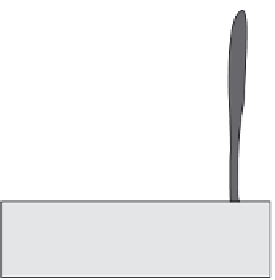Biomedical Engineering Reference
In-Depth Information
Resin
Hybrid layer
Demineralized
dentin zone
Mineralized
dentin
Collagen fibrils
FIGURE 7.7
Schematic illustration of demineralized dentin zone of total-etch adhesives. Inadequate resin infiltration into
collagen fibrils leaves nano- or microspaces within the adhesive interface. This zone is not common for self-
etching adhesive systems. Collagen hydrolysis of the demineralized dentin zone is one of the degradation
patterns for total-etch adhesives. In the absence of a demineralized dentin zone within the bonds, this
collagen hydrolysis does not occur because the encapsulation of cured adhesive resins or protection of the
mineral matrix of dentin prevents chemical degradation of the collagen fibrils even after long-term function.
The self-etching (etch-and-dry)
[14]
adhesives utilize simultaneous etch and prime of the dental
substrates. These adhesives do not require a separate acid-etching step. They are less technique sen-
sitive, compared to the etch-and-rinse ones, due to the lack of wet bonding approach. However,
water-free self-etching adhesives require the wet dentin surface, which raise the same question
again: how wet is wet?
[14]
They are also user friendly, due to the decrease in clinical bonding
steps and shortening application time.
Self-etching adhesives were introduced as two-step adhesives, where the self-etching primer and
adhesive are presented in two separate bottles or as one-step adhesives, where all components are
presented in single solution. The one-step self-etching adhesives can be provided either as mixed/
two-bottles adhesives or no-mix/single-bottle adhesives.
Self-etching adhesives simultaneously etch and infiltrate the tooth substrate, which ensure a com-
plete infiltration of the demineralized zone. On the other hand, they are not free from shortcomings
(
Figure 7.8
). The decrease in 24-h bond strength as well as a limited durability of such adhesive com-
pared to multistep adhesives was reported. HEMA-containing adhesives suffer from water sorption
and HEMA-free adhesives are prone to phase separation. Decrease in the shelf-life of such adhesives
that combine all components in a single bottle is another shortcoming for such adhesives
[14]
.
7.3.3
Glass ionomer adhesive
Glass ionomer adhesive is considered a two-step etch-and-rinse adhesive, its chemical composition
being based on the glass ionomer cement. It is the diluted version of the RMGI cement, Fuji II LC.











